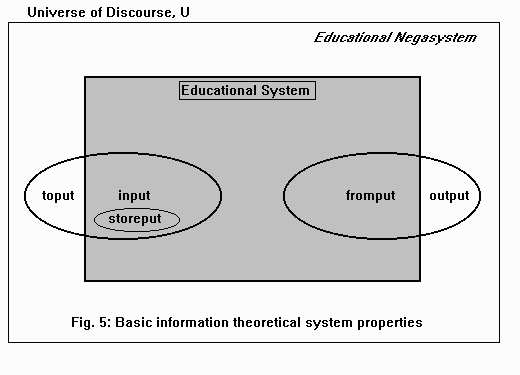 Educational Systems Theory
Educational Systems Theory Educational Systems Theory
Educational Systems Theory

Graduating high school students who are accepted into a university, or graduating college students who are hired to teach high school are output from those education systems and become input to new education systems.
#5. If educational system toput increases, then input increases to some value and then decreases.
#10. If educational system input decreases, then fromput decreases.
#11. If educational system input decreases, then storeput decreases.
#12. If educational system input increases, then filtration decreases.
#13. If educational system input decreases, then filtration increases.
#14. If educational system input is greater than some value, then regulation decreases.
#35. If educational system input is constant and fromput is constant, then output is constant.
#36. If educational system input increases and storeput is constant, then feedout increases.
#37. If educational system input increases and storeput is less than some value, then change in input equals change in storeput.
#38. If educational system input is greater than change in feedthrough, then spillage increases.
#39. If educational system input is greater than some value and spillage is less than some value, the storeput increases.
#40. If educational system input is less than some value and spillage is less than some value, the storeput decreases.
#41. If educational system input is constant and efficiency at a given time is less than some value, then efficiency increases.
#42. If the ratio of maximum educational system selective information to input decreases, then feedout decreases.
#45. If educational system output increases and feedback is greater than some value, then input increases.
#50. Change in educational system input is greater than change in fromput.
#107. The educational system complete connectedness increases or strongness increases, then input increases.
#110. If educational system complete connectedness increases or strongness increases, then openness is less than change in fromput, and change in fromput is less than change in input.
#115. If educational system unilateralness or weakness increases or disconnectedness increases, then input decreases and fromput decreases.
#150. If educational system automorphism increases, then input increases and storeput increases and fromput decreases and feedout decreases and filtration decreases and spillage decreases and efficiency decreases.
 Go to SIGGS Home Page.
Go to SIGGS Home Page.